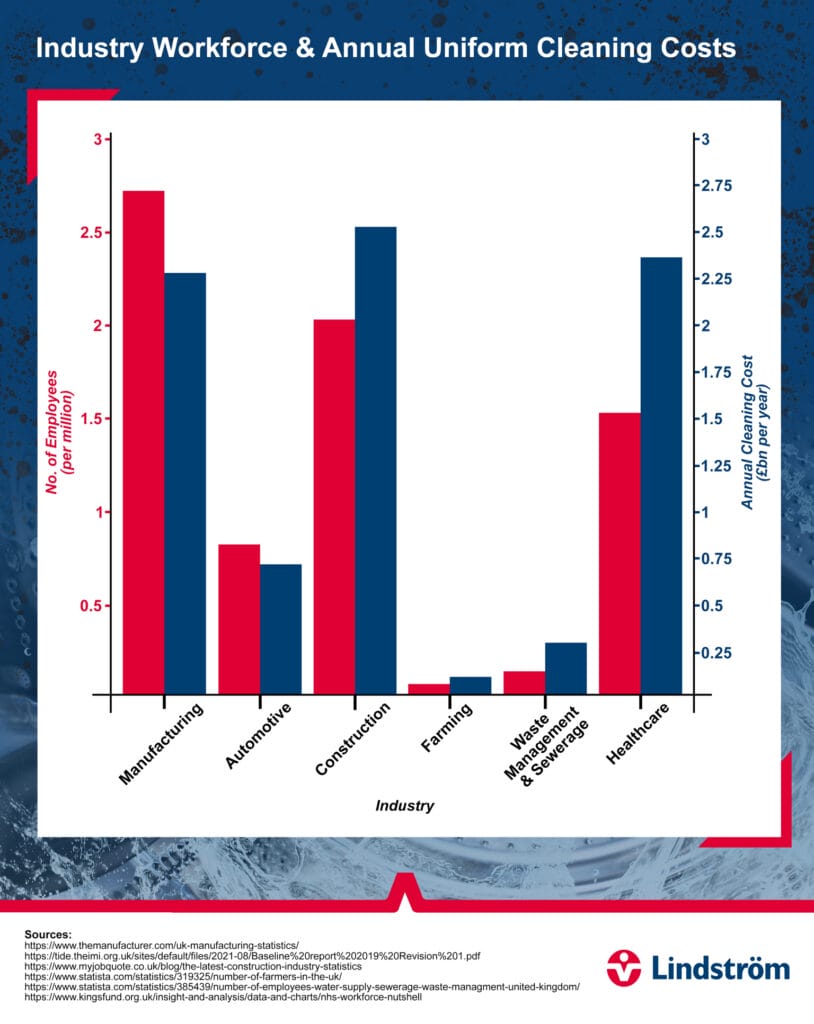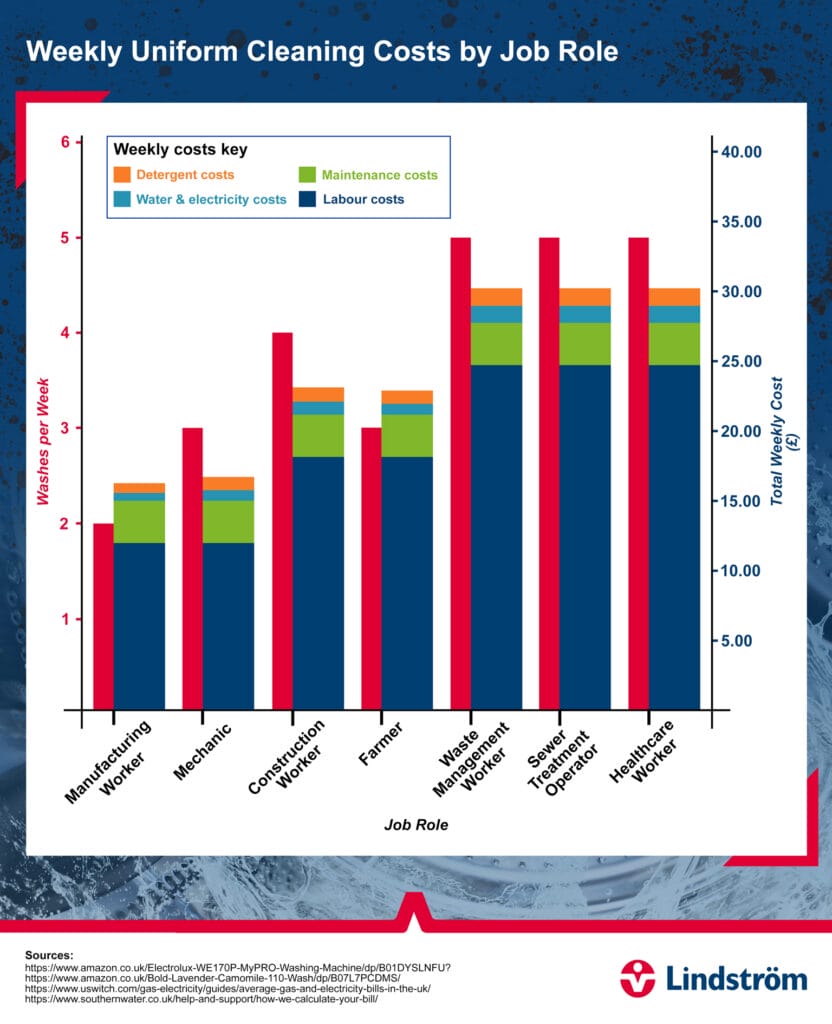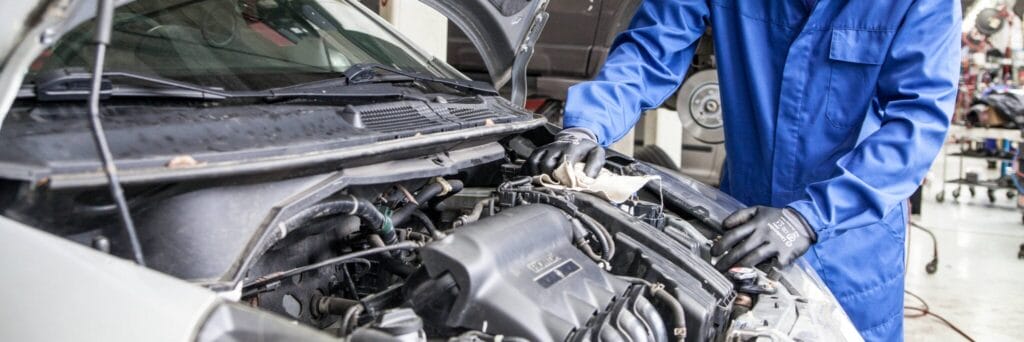
The UK’s Dirtiest Jobs Rack Up Over £8 Billion in Laundry Expenses Annually
Maintaining clean uniforms are essential for professionals working in high-contamination environments, from mechanics and construction workers to healthcare professionals and waste management staff.
Many businesses and individuals opt for in-house cleaning, but how much does this truly cost in terms of time, money, and effectiveness?
This cost analysis delves into the financial aspect of in-house uniform cleaning, illustrating the hidden expenses faced by workers and businesses in some of the UK’s dirtiest jobs.
Our research calculates that the total cost of uniform cleaning across these industries surpasses £8 billion annually, highlighting the significant financial impact on businesses nationwide.
Our findings reveal that maintaining hygiene can cost over £1,500 per year, per staff member—an expense that quickly scales up when applied across entire workforces.
Industry Workforce & Annual Uniform Cleaning Costs
To understand the scale of uniform cleaning costs across industries, we’ve gathered data on the number of employees in each sector and estimated their total annual cleaning expenses.

Sources: [1], [2], [3], [4], [5], [6]
These figures highlight the massive financial impact of uniform cleaning on businesses across the UK, with certain industries collectively spending billions annually.
Weekly Uniform Cleaning Costs by Job Role
Each profession has different uniform cleaning needs, depending on contamination levels, work environment, and hygiene regulations. Below is a breakdown of estimated weekly costs per worker:

Sources: [7], [8], [9], [10]
The Hidden Costs of DIY Uniform Cleaning
To assess the true cost of cleaning workwear in-house, we’ve considered key factors, including:
- Detergent expenses
- Water and electricity usage
- Machine maintenance costs
- Labour time for washing, drying, and ironing
Breakdown of Cleaning Costs Per Wash
For consistency, all calculations are based on the Electrolux WE170P MyPRO washing machine [7], a commercial-grade washer commonly used in businesses.
Here’s a cost breakdown of typical cleaning expenses:
Washing Machine Specifications: Electrolux WE170P MyPRO
- Water Consumption: 65 litres per cycle
- Energy Consumption: 0.7 kWh per cycle
Detergent Costs
- Product: Bold Professional Washing Powder Lavender & Camomile 110 Washes (7.5 kg) [8]
- Cost: £33.97 per box
- Cost per Wash: £33.97 / 110 washes = £0.308 per wash
Utility Costs
- Water: £1.958 per cubic meter (1,000 litres) [9]
- Electricity: £0.245 per kWh [10]
Maintenance and Labour Costs
- Machine Maintenance: Estimated at £150 annually per machine, approximately £2.88 per week [11]
- Labour (New Living Wage): £12.21 per hour [12]
Cost Breakdown by Job Role
1. Manufacturing Worker
Manufacturing workers typically work in controlled environments but still face exposure to dust, chemicals, and machinery residues, necessitating regular cleaning to maintain hygiene and safety.
- Washes per Week: 2
- Detergent: £0.308 × 2 = £0.62
- Water: 65 L × 2 = 130 L = 0.13 m³ × £1.958 = £0.25
- Electricity: 0.7 kWh × 2 = 1.4 kWh × £0.245 = £0.34
- Maintenance: £2.88
- Labour: 1 hour = £12.21
Total Weekly Cost: £16.30
2. Mechanic
Mechanics frequently handle grease, oil, and chemicals that can accumulate on clothing, making multiple washes per week necessary to prevent contamination and maintain cleanliness.
- Washes per Week: 3
- Detergent: £0.308 × 3 = £0.92
- Water: 65 L × 3 = 195 L = 0.195 m³ × £1.958 = £0.38
- Electricity: 0.7 kWh × 3 = 2.1 kWh × £0.245 = £0.51
- Maintenance: £2.88
- Labour: 1 hour = £12.21
Total Weekly Cost: £16.90
3. Construction Worker
Construction workers face daily exposure to dust, cement, and hazardous materials like silica , requiring frequent laundering to reduce respiratory risks and maintain visibility of high-vis clothing.
- Washes per Week: 4
- Detergent: £0.308 × 4 = £1.23
- Water: 65 L × 4 = 260 L = 0.26 m³ × £1.958 = £0.51
- Electricity: 0.7 kWh × 4 = 2.8 kWh × £0.245 = £0.69
- Maintenance: £2.88
- Labour: 1.5 hours = £18.32
Total Weekly Cost: £23.63
4. Farmer
Farmers work in environments filled with soil, pesticides, and animal waste, meaning their uniforms require frequent washing to remove contaminants and ensure hygiene.
- Washes per Week: 3
- Detergent: £0.308 × 3 = £0.92
- Water: 65 L × 3 = 195 L = 0.195 m³ × £1.958 = £0.38
- Electricity: 0.7 kWh × 3 = 2.1 kWh × £0.245 = £0.51
- Maintenance: £2.88
- Labour: 1.5 hours = £18.32
Total Weekly Cost: £23.79
5. Waste Management Worker
Waste management workers handle refuse, biohazards, and potential pathogens daily, making high-frequency uniform cleaning critical to prevent illness and cross-contamination.
- Washes per Week: 5
- Detergent: £0.308 × 5 = £1.54
- Water: 65 L × 5 = 325 L = 0.325 m³ × £1.958 = £0.64
- Electricity: 0.7 kWh × 5 = 3.5 kWh × £0.245 = £0.86
- Maintenance: £2.88
- Labour: 2 hours = £24.42
Total Weekly Cost: £30.34
6. Sewage Treatment Operator
Operators work with raw sewage and wastewater, exposing them to high levels of bacteria and viruses, necessitating daily washes at high temperatures to maintain hygiene.
- Washes per Week: 5
- Detergent: £0.308 × 5 = £1.54
- Water: 65 L × 5 = 325 L = 0.325 m³ × £1.958 = £0.64
- Electricity: 0.7 kWh × 5 = 3.5 kWh × £0.245 = £0.86
- Maintenance: £2.88
- Labour: 2 hours = £24.42
Total Weekly Cost: £30.34
7. Healthcare Worker
Healthcare professionals are exposed to bodily fluids, bacteria, and pathogens, requiring stringent hygiene protocols, including daily laundering at high temperatures to prevent the spread of infections.
- Washes per Week: 5
- Detergent: £0.308 × 5 = £1.54
- Water: 65 L × 5 = 325 L = 0.325 m³ × £1.958 = £0.64
- Electricity: 0.7 kWh × 5 = 3.5 kWh × £0.245 = £0.86
- Maintenance: £2.88
- Labour: 2 hours = £24.42
Total Weekly Cost: £30.34
Key Findings
High-frequency cleaning is expensive – Roles like healthcare, waste management, and sewage treatment, where uniforms require washing five times a week, cost over £30 per worker per week.
Labour is the biggest cost factor – The time spent washing, drying, and ironing uniforms is often overlooked but represents the largest single cost in the process.
Dirty jobs come with high maintenance demands – Professions with exposure to contaminants, pathogens, and hazardous materials face rigorous cleaning requirements, significantly impacting time and expenses
Additional Costs
Beyond the direct costs of laundering, businesses face several other uniform-related expenses that add significantly to the overall cost.
Multiple Uniforms Per Worker
Most workers require more than one uniform set to accommodate daily washing cycles. A single uniform is often insufficient, meaning employees or businesses must invest in multiple sets, effectively doubling or tripling the initial purchase cost.
Initial Purchase Costs
High-quality uniforms, particularly those designed for protection in hazardous environments, come with a hefty price tag.
Flame-resistant coveralls, waterproof gear, and high-visibility clothing can range from £50 to over £200 per set, depending on industry requirements.
Company Branding and Customisation
Many businesses invest in customised uniforms featuring embroidered logos, name tags, or corporate colours. While this adds a professional touch, it also increases costs significantly, with customisation expenses often adding £5-£20 per uniform.
Replacement Costs Due to Wear and Tear
Workwear is subjected to heavy use, leading to frequent damage and deterioration. In high-risk environments, uniforms must be replaced regularly due to tears, stains, or safety compliance requirements.
Some industries see uniforms replaced every 6-12 months, adding an ongoing expense for businesses.
These hidden costs are essential considerations for businesses evaluating the true price of maintaining professional, hygienic workwear.
Additionally, tracking garments throughout the laundering process can be a challenge, with misplaced or lost uniforms adding to replacement expenses. Implementing garment tracking solutions, such as RFID tagging, can help businesses reduce losses and improve inventory management which will add to the initial investment costs.
Conclusion
With weekly uniform cleaning costs ranging from £16.30 to £30.34 per worker, the hidden expenses of maintaining hygiene quickly add up.
While some professions require fewer washes due to controlled environments, others—such as waste management, sewage treatment, and healthcare—demand frequent laundering to ensure worker safety and compliance with hygiene standards.
In addition to cleaning costs, businesses must also consider the expense of multiple uniform sets, branding, and uniform replacements due to wear and tear.
The true cost of maintaining workwear extends beyond just detergent and electricity, making it a major financial consideration for employers. Understanding these costs is crucial for businesses looking to manage expenses effectively while maintaining high hygiene standards.
Whether through in-house cleaning or professional uniform rental services, ensuring clean and compliant workwear is a necessary investment in worker safety and well-being.
Sources:
[1] https://www.themanufacturer.com/uk-manufacturing-statistics/
[2] https://tide.theimi.org.uk/sites/default/files/2021-08/Baseline%20report%202019%20Revision%201.pdf
[3] https://www.myjobquote.co.uk/blog/the-latest-construction-industry-statistics
[4] https://www.statista.com/statistics/319325/number-of-farmers-in-the-uk/
[6] https://www.kingsfund.org.uk/insight-and-analysis/data-and-charts/nhs-workforce-nutshell
[7] Electrolux WE170P MyPRO Specifications, https://www.amazon.co.uk/Electrolux-WE170P-MyPRO-Washing-Machine/dp/B01DYSLNFU?source=ps-sl-shoppingads-lpcontext&ref_=fplfs&psc=1&smid=A3R3O81W7GF4BK
[8] Bold Professional Washing Powder on Amazon
[9] https://www.uswitch.com/gas-electricity/guides/average-gas-and-electricity-bills-in-the-uk/
[10] https://www.southernwater.co.uk/help-and-support/how-we-calculate-your-bill/
[11] https://www.checkatrade.com/blog/cost-guides/washing-machine-repair-cost/




